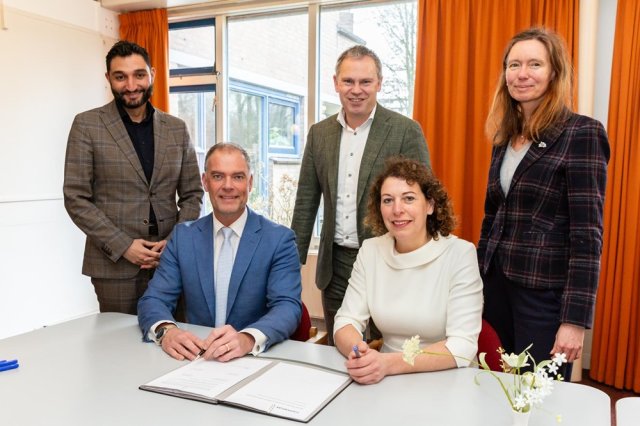Zoetermeer pushes for additional housing by 'opting up, sticking on and plinking out'
Housing corporations De Goede Woning, Stedelink and Vidomes and the municipality of Zoetermeer are joining forces to realize 400 to 700 additional homes. They want to achieve this by expanding existing buildings through adding on, attaching and plinths. By signing the letter of intent, the parties confirm their joint ambition and take a step forward in this innovative approach.
Boarding up involves adding one or more residential floors on top of an existing building. Bonding involves adding additional residential units to the sides of an existing building. Plinths means that the bottom layer of a building (the plinth) is converted into housing or other living spaces, instead of, for example, storage rooms or garages. Making better use of existing buildings can thus contribute to reducing the housing shortage in Zoetermeer.
In addition to reducing the housing shortage, boarding up, boarding up and boarding out can also help improve the living environment. Consider, for example, improving safety, greenery and the appearance of the building. If we simultaneously address the existing buildings, it also provides opportunities for lower energy costs through sustainability, making the existing housing more accessible and adding a diverse housing supply and additional amenities such as meeting rooms and care facilities.
Sample
In 2024, the possibility of adding additional housing units to existing housing corporation complexes in Zoetermeer by means of topping up, attaching and plinths was investigated. This shows that there is potentially room for 400 to 700 new homes. With the signing of the letter of intent, the parties will start a pilot project, in which suitable complexes will be selected and the feasibility further investigated.
Impact of topping, pasting and plating
The housing corporations and the municipality are committed to careful participation in which residents, neighbors and resident representatives are intensively involved. Consideration is also given to the impact on the surrounding area - such as parking facilities, shadowing and construction nuisance. In this way, plans are better tailored to the needs of the neighborhood and create support for future developments.
Alderman Ronald Weerwag (Housing) is pleased with this step: "Optoppen, aanplakken and uitplinten offer innovative solutions to the housing shortage in Zoetermeer, with the involvement and participation of residents and local residents at the center of building together a sustainable and livable city."
Leaders nationwide approach to opting out
Zoetermeer is one of the national frontrunners in the Netherlands in the field of opting up. Since 2024, Zoetermeer, along with 4 other municipalities - Ede, Eindhoven, Leeuwarden and Rotterdam - has been working with the national government to explore a successful approach to area-based optopping. In these cities, which have many post-war neighborhoods, there is a lot of potential for optopping. The goal of the collaboration is to gain and share knowledge and experiences.
The Province of South Holland welcomes the commitment of Zoetermeer and the corporations. The plan is to build nearly a quarter of a million homes through 2030. Optopping is a way of building that is good for house seekers, existing residents and the neighborhood. That is why provincial executive Anne Koning was also present at the signing.
"So many people are looking for a good place to live," said King. "With upzoning, existing buildings are being refurbished and made even more vibrant. Which means new energy is coming back into existing neighborhoods and that's really good news."

